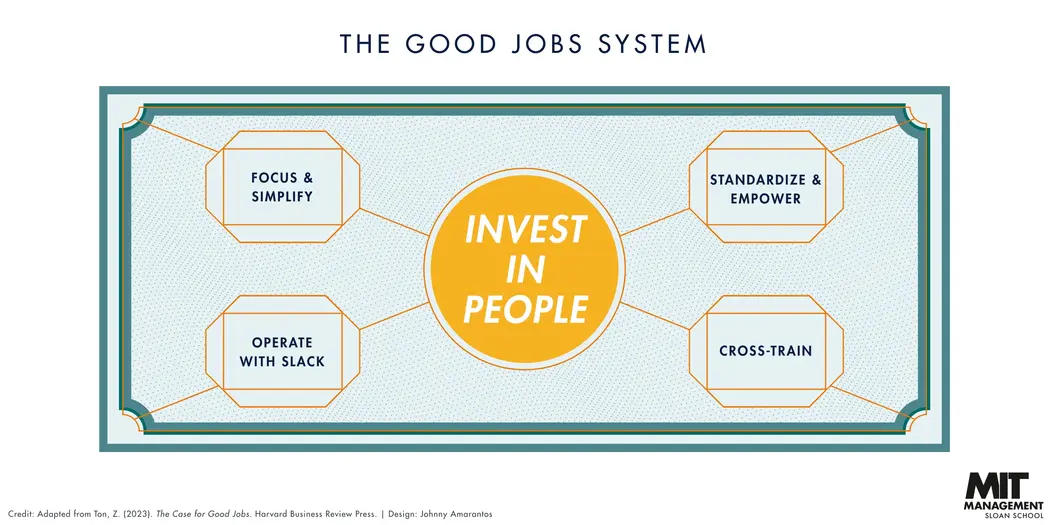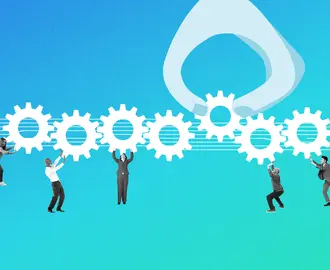Credit: Mimi Phan / iStock
MIT Sloan professor of the practice is an expert in operations design and management and how organizations can simultaneously balance employee, customer, and investor satisfaction.
Almost a decade ago, Ton published “The Good Jobs Strategy,” which drew from 15 years of research on companies that offered good jobs while creating value for all of their stakeholders. She is also a co-founder of the nonprofit Good Jobs Institute, which helps corporate executives apply the good jobs strategy in their own organizations.
In this excerpt from her new book, “The Case for Good Jobs: How Great Companies Bring Dignity, Pay, and Meaning to Everyone’s Work,” Ton outlines the importance of investing in employees, and the four operational choices managers must make.
++++++
I originally studied four low-cost retailers (Mercadona, Spain’s largest supermarket chain; Trader Joe’s, an American supermarket chain; QuikTrip, an American convenience store chain; and Costco) operating in a virtuous cycle of high investment in employees and high performance.
I saw that they all made four operational choices that made it possible to invest much more in their frontline people and deliver much more to their customers than their mediocre peers operating in a vicious cycle did — or than they themselves had been doing before taking the turn to good jobs.
Those four operational choices are: focus and simplify; standardize and empower; cross-train; operate with slack.
These operational choices make employees’ work better. Still, even the best-designed work can’t succeed without a stable, able, and motivated workforce. And even a well-paid, well-trained workforce will be defeated by the wrong operational choices. So these four operational choices must be combined with employee investment. I call this combination the good jobs system. It is a system that prioritizes customers and is designed to maximize employee productivity, motivation, and contribution.
Here is a brief overview of the elements of the good jobs system and how they differ from the system of companies that operate in a vicious cycle.
Invest in people
The mental model at companies that operate in a vicious cycle is primarily financial and therefore inevitably views employees as a cost to be minimized. Frontline wages are based on the going market rate in that area, as if labor were like any other input to production. High employee turnover is treated as something to live with, like equipment maintenance.
Conversely, the mental model at companies with a good jobs system is customer centric and therefore recognizes that frontline employees — the ones face-to-face with the customers — are the ones driving differentiation, growth, and profitability.
These employees aren’t the picks and shovels — they’re the gold. When you’re customer centric, high employee turnover is a cost you can’t tolerate. So those companies invest what it takes to attract the right people, train them, retain them, and keep expectations high. That investment includes higher wages, more stable schedules, promotion from within, and strong hiring, training, and performance management.
The following are the four operational choices:
1. Focus and simplify
The mental model at companies that operate in a vicious cycle is for headquarters functions to make decisions to improve their own metrics and leave the frontline workers to figure out how to deal with the consequences of those decisions. Silos at headquarters constantly add products, services, projects, tools, and pilots. These activities — often uncoordinated — create an increased and uneven workload in the front lines. Last-minute changes to deliveries, pilots, and corporate visits make the workload unpredictable.
Meanwhile, at companies with a good jobs system, decisions always put customers ahead of short-term financial performance. But these companies also recognize that customer focus is not the same as being all things to all people. They maintain clarity about what value they offer their customers and what they give up. The mental model at these companies is that the most important work is done in the front lines where customers meet the company. Therefore, everyone should work on simplifying flow and work to ensure that the frontline workers can serve the customer well. Simplifying includes maintaining discipline in doing only what adds value for the customer, eliminating wasteful and low-value-added activities, and making the workload smoother and more predictable.
2. Standardize and empower
The mental model at companies that operate in a vicious cycle is command and control. Headquarters thinks and frontline workers do. There’s a rule for everything. Information flows one way from the top to the bottom — there’s no reason to build a structure for flowing information from the front lines to the headquarters.
The mental model at companies with a good jobs system is to leverage frontline ability, knowledge, and time to serve the customer well and pursue bottom-up continuous improvement. These companies standardize routine processes — with frontline input — to increase efficiency and consistency and to reduce employees’ mental overload, then empower employees to engage in improvement and to make decisions to increase customer satisfaction. These companies also create structures to hear employee ideas.
3. Cross-train
To cut costs, companies that operate in a vicious cycle either have their employees perform narrow tasks or ask them to cover more than they are trained or able to do.
The mental model of companies with a good jobs system is to maximize the productivity of their employees and to foster ownership. To that end, they cross-train employees to do both customer-facing and non-customer-facing tasks so that they can adjust productively to changes in customer traffic. Cross-training is done in a way that ensures ownership and allows for specialization.
4. Operate with slack
When employees are seen as a cost to be minimized, the tendency is to staff the work environment with as few people as possible. Mistakes, burnout, and poor customer service are tolerated for the sake of keeping costs down.
Companies with a good jobs system prioritize customers and see their employees as a driver of customer value and continuous improvement. They staff their businesses with more hours of labor than the expected workload so that employees can do their jobs without rushing and can respond to customer demand even during peak periods. Operating with slack also ensures that employees can take time off without letting their team down and managers have time to develop people and create a strong talent pipeline.
Excerpted from “The Case for Good Jobs: How Great Companies Bring Dignity, Pay, and Meaning to Everyone’s Work,” by Zeynep Ton. © 2023 Zeynep Ton. Reprinted by permission of Harvard Business Review Press. All rights reserved.




